
From Landfill to Landscaping
August 22, 2011
By
Heather Hager
One man’s trash is another man’s treasure, or so the saying goes.
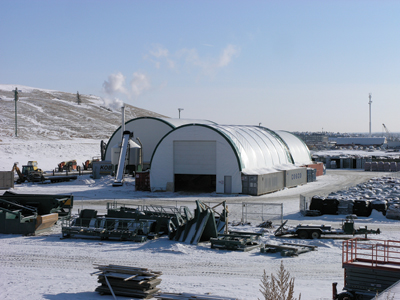 |
|
| Clean lumber from the 110-acre landfill is ground and then coloured, bagged, and palletized in these cover-all units.
|
One man’s trash is another man’s treasure, or so the saying goes. This is certainly evident at Ecco Waste Systems, in Calgary, Alberta, where they’ve been turning wood waste into saleable mulch products for about eight years now. Diverting clean wood from the landfill is also extending the life of the site, allowing it to remain in operation for additional years.
The private site began operating as a dry waste landfill in 1994, but it wasn’t until about 2002 that the owners started looking at opportunities to recycle, explains Ken Hamman, managing director of Ecco Waste Systems. With the majority of materials coming from manufacturing, construction, and demolition activities, a good half of that material is raw wood and manufactured wood products such as plywood and oriented strand board. About half of that mix is clean dimension wood from construction/demolition and old pallets. That’s what is made into the mulch product.
When the company first began making mulch in 2003, a Rotochopper grinder processed and then coloured the product, which they called Ecco Chips. In 2007, they purchased a Bandit Beast grinder, along with an attachment for colouring the mulch as it was ground. In spring 2010, they decided to use the Beast for grinding only and purchased a Sahara-model Colorbiotics colourizer for dying the mulch. Ian Traquair, sales and marketing manager for Ecco Chips, says that the new colourizer cut their dye use by almost two-thirds.
“It’s like a big mix-master turned sideways,” describes Traquair. “With this machine, from the time the mulch hits the vat to the time it comes out, it’s probably in there a good minute to minute and a half. So the whole time it’s turning, it’s being sprayed, and it’s being mixed.” He says that this results in good colour consistency and reduces the amount of water that’s required to mix with the dye.
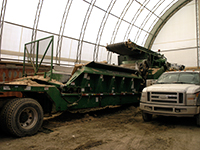 |
|
| The Bandit Beast grinder gets some routine tooth maintenance in one of two biomass-heated cover-all buildings on-site. “It’s a substantial piece of equipment, but it has taken a lot of wear from inadvertent introduction of metals,” says Ken Hamman, managing director of Ecco Waste Systems.
|
“Wood material for the mulching operation is currently ground outside and then moved to a cover-all unit,” says Hamman. Uncoloured mulch is stockpiled away from snow and rain in the main cover-all unit, while colouring, bagging, and palletizing occur in a smaller, adjacent unit. Another more recently installed cover-all unit has increased the storage space, allowing more raw mulch to be stockpiled prior to the busy pre-spring colouring season.
About 95% of the landscape mulch the company sells is coloured; the remainder is left in its natural state. For colouring, a small Cat loader in the cover-all places the mulch onto a conveyor, which takes the material through the partition and drops it into the colourizer. Once coloured, the mulch is either bagged or shipped in bulk in two walking floor trailers that the company owns. Bagging is done on a semi-automatic Verville bagging line that was bought used in 2008. Workers stack the bags onto pallets, which are sealed using a SIAT Paklet pallet wrapping machine. The pallets are stored outdoors or in old rail boxcars.
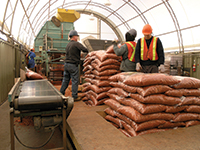 |
|
| The current semi-automatic bagging and palletizing system is fairly labour intensive, so the company is looking to upgrade to a fully automated system.
|
Mulch Markets
“Tonnage-wise, probably 40% of the landscape mulch is bagged, and 60% is bulk,” says Traquair. “Bags are where the profit is. Bulk is where the volume is. So there’s a nice kind of a balance.” The company is hoping to upgrade to a fully automated bagging and palletizing line by fall of 2011. “If we see the same savings with a fully automated system that we saw with the colourizer, I can go for a pay raise,” laughs Traquair.
Ecco currently produces about 5,000 tonnes/year of landscape mulch. It’s shipped to independent garden centres and bulk distributors, from Thunder Bay, Ontario, to Vancouver Island, British Columbia. All interprovincial trucking is done by commercial carriers. The company produces another 5,000 tonnes/year or so of fine, screened mulch that’s used for animal bedding, particularly for feedlots. The coloured mulch market is very seasonal, with about 70% of the product needing to be produced in the three months before the onset of spring. The rest of the coloured mulch is produced up until early fall. Producing mulch for the bedding market helps to fill in some of the coloured mulch downtime, says Traquair.
Ecco also does some co-bagging of landscape mulch for other companies. “They are usually from somewhere in eastern Canada, but they have a national account they could sell to in Calgary, Edmonton, or Vancouver. So they want to get a product that’s closer so it doesn’t cost them as much to ship it,” explains Hamman.
The company is also involved with the local community through associations such as the Clean Calgary Association and the Recycling Council of Alberta, says Traquair. In the past, they’ve donated landscape material to four or five local schools and some community associations, as well as the City of Calgary BP Birthplace Forest.
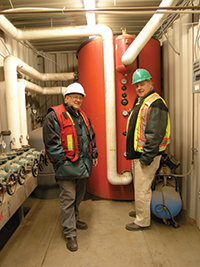 |
|
| Ken Hamman, managing director of Ecco Waste Systems (left), and Ian Traquair, sales and marketing manager for Ecco Chips (right), show the biomass-heated boiler.
|
Wood heating
Aside from mulch and animal bedding, a small portion of the clean, ground wood feeds a biomass boiler that allows workers to function comfortably inside the uninsulated cover-all units during winter. Installed in 2008 by Fink Machine out of Enderby, British Columbia, the 540-kW KOB (Viessmann) Pyrot boiler is fully automated and came as a containerized package. Ecco chose the boiler because it’s a low-pressure system and therefore doesn’t require a steam engineer to operate it. “With a little bit of training, even a sales manager can learn to run it,” laughs Traquair.
Wood fuel is supplied from a 45 cubic-metre Meridian silo. Occasionally, a stone or small metal piece will cause slagging or an auger to jam. But as long as the fuel is clean, the boiler “runs pretty darn well,” says Hamman.
The boiler uses about 250 tonnes of wood in a heating season. It’s not that much compared to the mulch production, but it provides “a significant savings over using propane or natural gas to heat the facilities,” says Traquair. “It doesn’t take long for those boilers to pay for themselves.”
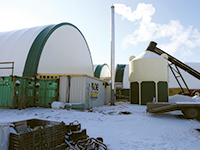 |
|
| The KOB biomass boiler burns 24 hours/day in wintertime.
|
Future plans
Ecco Waste Systems is now in the process of building and permitting a material recovery facility (MRF) that will eventually sort and recycle a majority of the waste that arrives at the site. “In about 2004, we started looking at different options for processing all or much of the waste stream, and we visited MRFs all across the country, primarily in the United States, but there are a few in Canada too,” says Hamman. In the MRF, a sequence of equipment and sorters separates all the materials (i.e., wood, plastics, cardboard, paper, metals, and gypsum), and sends them to different streams, which will help save even more space in the landfill. The clean wood would continue to supply their current markets, as well as feed a second KOB boiler installed in the MRF to provide heating. The company also anticipates making refuse-derived fuel (RDF) from the mixed wood debris, for which there are already potential industrial-scale customers.
Hamman says that they’re also considering the possibility of using RDF to produce heat and power for the MRF. “Our power cost for a single shift at this MRF is estimated to be in the range of $850,000 a year. So it’s an awful lot of money being paid for power, which we could generate.” However, he says, they are still considering whether they want to become a power generator, which would be another new venture for the company.
Print this page